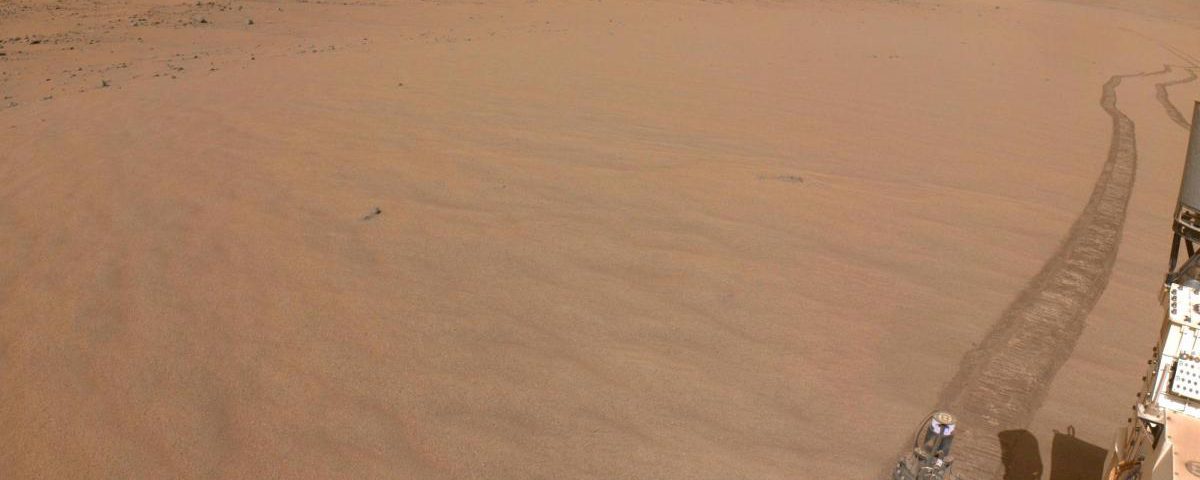NASA’s Mars rover just emerged from Jezero Crater. So, what next?

NASA unveils first look at SUV-sized Mars Chopper concept
December 28, 2024
NASA Now Knows Why Its Mars Helicopter Crashed
December 28, 2024NASA’s Mars rover just emerged from Jezero Crater. So, what next?
After a three-and-a-half month climb, NASA’s Perseverance rover has finally reached the top of the Jezero Crater rim. So, what now?
Full Article
NASA personnel are celebrating the news that its Perseverance rover has finally reached the top of the Mars’ Jezero Crater rim after a challenging climb that took three-and-a-half months to complete. The six-wheeled rover ascended 1,640 feet (500 meters) and made stops along the way to conduct various science observations as it continues its search for signs of ancient microbial life on the red planet. “During the Jezero Crater rim climb, our rover drivers have done an amazing job negotiating some of the toughest terrain we’ve encountered since landing,” said Steven Lee, deputy project manager for Perseverance at NASA’s Jet Propulsion Laboratory (JPL) in Southern California. “They developed innovative approaches to overcome these challenges — even tried driving backward to see if it would help — and the rover has come through it all like a champ.” Lee added: “Perseverance is ‘go’ for everything the science team wants to throw at it during this next science campaign.” The rover, which is about the size of a small car, had been exploring the floor of the crater, as well as the site of an ancient river delta, since landing there in spectacular fashion in 2021. Exploring beyond the crater allows the rover team to investigate regions that have not been previously studied, potentially revealing different geological features and histories on Mars. Perseverance’s next science campaign is called Northern Rim as its route will cover the northern part of the southwestern section of Jezero’s rim. During the next year, the rover will visit as many as four sites of geologic interest, taking samples along the way, driving about 4 miles (6.4 kilometers). “The Northern Rim campaign brings us completely new scientific riches as Perseverance roves into fundamentally new geology,” said Ken Farley, project scientist for Perseverance at Caltech in Pasadena. “It marks our transition from rocks that partially filled Jezero Crater when it was formed by a massive impact about 3.9 billion years ago to rocks from deep down inside Mars that were thrown upward to form the crater rim after impact.” Farley said that the rocks represent “pieces of early martian crust and are among the oldest rocks found anywhere in the solar system,” adding that investigating them “could help us understand what Mars — and our own planet — may have looked like in the beginning.” After Northern Rim, Perseverance will head to Witch Hazel Hill, a scientifically significant rocky outcrop about 1,500 feet (450 meters) down the other side of the rim. Candice Bedford, a Perseverance scientist from Purdue University in West Lafayette, Indiana, said Witch Hazel Hill comprises more than 330 feet of layered outcrop, “where each layer is like a page in the book of martian history. As we drive down the hill, we will be going back in time, investigating the ancient environments of Mars recorded in the crater rim. Then, after a steep descent, we take our first turns of the wheel away from the crater rim toward Lac de Charmes, about 2 miles south.” Lac de Charmes is of particular interest as its location means it’s less likely to have been significantly affected by the formation of Jezero Crater. Perseverance will then move on to an outcrop of large blocks known as megabreccia, which JPL said may represent ancient bedrock broken up during the Isidis impact, a planet-altering event some 3.9 billion years ago that likely penetrated deep into the martian crust as it created an impact basin some 745 miles (1,200 kilometers) wide. Emerging from Jezero Crater is a major milestone for Perseverance, so stay tuned for updates on the next phase of its mission over the coming months. A screenshot from actual footage of NASA’s Perseverance rover landing on Mars in 2021. NASA/JPL It’s exactly three years since NASA’s rover, Perseverance, touched down on Mars in spectacular fashion. A Mars landscape with NASA’s Ingenuity helicopter seen on the dune in the distance. NASA/JPL-Caltech/ASU NASA’s Mars rover, Perseverance, has captured an image (above) showing the final resting place of the damaged Mars helicopter, Ingenuity. It’s been a couple of weeks since NASA’s Mars helicopter, Ingenuity, took its final flight on the red planet. It was grounded for good after suffering damage to one of its propellers during its 72nd and final flight. But despite the disappointment, it was widely recognized that Ingenuity achieved much since arriving on Mars in February 2021. Upgrade your lifestyleDigital Trends helps readers keep tabs on the fast-paced world of tech with all the latest news, fun product reviews, insightful editorials, and one-of-a-kind sneak peeks.

